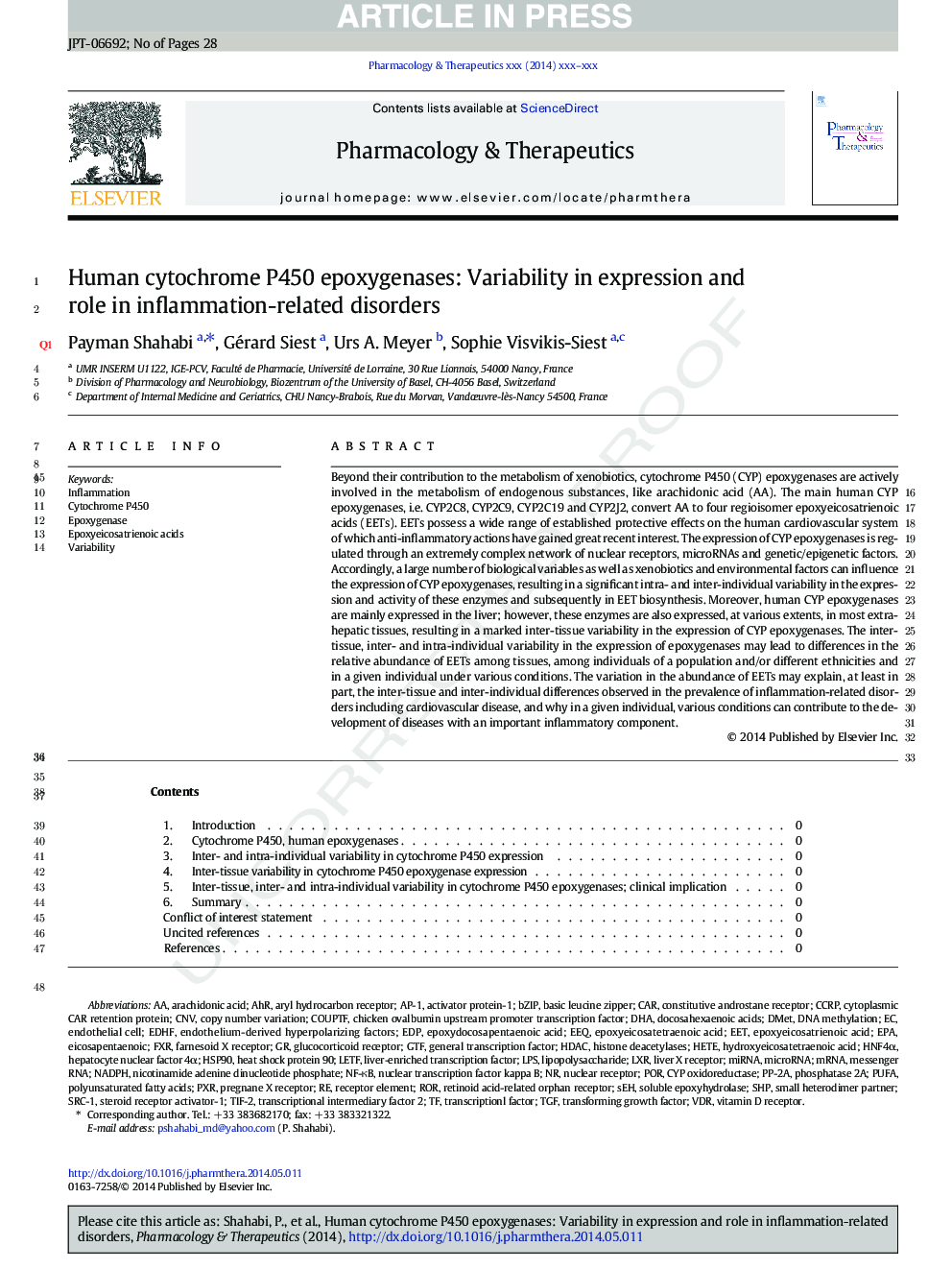| کد مقاله | کد نشریه | سال انتشار | مقاله انگلیسی | نسخه تمام متن |
|---|---|---|---|---|
| 5843997 | 1127493 | 2014 | 28 صفحه PDF | دانلود رایگان |
عنوان انگلیسی مقاله ISI
Human cytochrome P450 epoxygenases: Variability in expression and role in inflammation-related disorders
دانلود مقاله + سفارش ترجمه
دانلود مقاله ISI انگلیسی
رایگان برای ایرانیان
کلمات کلیدی
TGFNADPHHSP90HDACbZIPPORSRC-1PP-2AEEQAP-1SHPEDPGTFEDHFFXRVDREicosapentaenoicLXRHNF4αPXRLPSEPANF-κBCCRPLETFAHRmRNARORCNVfarnesoid X receptor - Farnesoid X گیرندهmessenger RNA - RNA messengersEH - SEHArachidonic acid - اسید آراشیدونیکepoxyeicosatrienoic acids - اسید اپوکسی اسیاتریتروئینepoxyeicosatrienoic acid - اسید اپوکسی اسیاتریتروئینepoxydocosapentaenoic acid - اسید اپوکسی سودوکواسپنتائوئیکepoxyeicosatetraenoic acid - اسید اپوکسییکواستاترونیکhydroxyeicosatetraenoic acid - اسید هیدروکسی اسیستاترونیکPolyunsaturated fatty acids - اسید چرب اشباع نشدهPUFA - اسید چرب چند غیراشباعDocosahexaenoic acids - اسیدهای داکسی هگزائینیکinflammation - التهاب( توروم) Epoxygenase - اپوکسیژنازtransforming growth factor - تبدیل فاکتور رشدVariability - تغییرپذیریcopy number variation - تنوع نسخه کپیEET - خوردنDHA - دوکوساهگزائنوئیک اسیدbasic leucine zipper - زیپ پایه لوسینEndothelial cell - سلول های اندوتلیالCytochrome P450 - سیتوکروم پی۴۵۰small heterodimer partner - شرکای کوچک همجنسگراtranscriptional intermediary factor 2 - ضریب واسطه رونویسی 2general transcription factor - عامل رونویسی عمومیLiver-enriched transcription factor - عامل رونویسی غنی شده با کبدhepatocyte nuclear factor 4α - عامل هسته ای hepatocyte 4αendothelium-derived hyperpolarizing factors - عوامل هیپرپولاریزاسیون حاصل از اندوتلیومnuclear transcription factor kappa B - فاکتور رونویسی هسته کاپا Bchicken ovalbumin upstream promoter transcription factor - فاکتور رونویسی پروموتر اپیدرم مرغPhosphatase 2A - فسفاتاز 2Alipopolysaccharide - لیپوپلی ساکاریدCAR - ماشینDNA methylation - متیلاسیون DNAMicroRNA - میکرو RNA MiRNA - میکروRNA، ریزآرانای، miRNAnicotinamide adenine dinucleotide phosphate - نیکوتین آمید adenine dinucleotide phosphateHETE - هفتهhistone deacetylases - هیستون deacetylasesHeat shock protein 90 - پروتئین شوک حرارت 90activator protein-1 - پروتئین فعال کننده-1liver X receptor - کبد X گیرندهaryl hydrocarbon receptor - گیرنده آرویل هیدروکربنconstitutive androstane receptor - گیرنده آندروستان پایدارVitamin D receptor - گیرنده ویتامین DPregnane X receptor - گیرنده پیش گران Xglucocorticoid receptor - گیرنده گلوکوکورتیکوئیدNuclear receptor - گیرنده هستهای، گیرندههای هستهای
موضوعات مرتبط
علوم پزشکی و سلامت
داروسازی، سم شناسی و علوم دارویی
داروشناسی
پیش نمایش صفحه اول مقاله

چکیده انگلیسی
Beyond their contribution to the metabolism of xenobiotics, cytochrome P450 (CYP) epoxygenases are actively involved in the metabolism of endogenous substances, like arachidonic acid (AA). The main human CYP epoxygenases, i.e. CYP2C8, CYP2C9, CYP2C19 and CYP2J2, convert AA to four regioisomer epoxyeicosatrienoic acids (EETs). EETs possess a wide range of established protective effects on the human cardiovascular system of which anti-inflammatory actions have gained great recent interest. The expression of CYP epoxygenases is regulated through an extremely complex network of nuclear receptors, microRNAs and genetic/epigenetic factors. Accordingly, a large number of biological variables as well as xenobiotics and environmental factors can influence the expression of CYP epoxygenases, resulting in a significant intra- and inter-individual variability in the expression and activity of these enzymes and subsequently in EET biosynthesis. Moreover, human CYP epoxygenases are mainly expressed in the liver; however, these enzymes are also expressed, at various extents, in most extrahepatic tissues, resulting in a marked inter-tissue variability in the expression of CYP epoxygenases. The inter-tissue, inter- and intra-individual variability in the expression of epoxygenases may lead to differences in the relative abundance of EETs among tissues, among individuals of a population and/or different ethnicities and in a given individual under various conditions. The variation in the abundance of EETs may explain, at least in part, the inter-tissue and inter-individual differences observed in the prevalence of inflammation-related disorders including cardiovascular disease, and why in a given individual, various conditions can contribute to the development of diseases with an important inflammatory component.
ناشر
Database: Elsevier - ScienceDirect (ساینس دایرکت)
Journal: Pharmacology & Therapeutics - Volume 144, Issue 2, November 2014, Pages 134-161
Journal: Pharmacology & Therapeutics - Volume 144, Issue 2, November 2014, Pages 134-161
نویسندگان
Payman Shahabi, Gérard Siest, Urs A. Meyer, Sophie Visvikis-Siest,